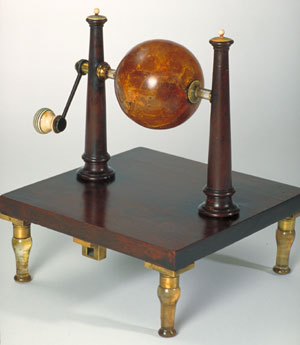
Northern Europe, ca 1765?
Copal Globe Generator
Northern Europe, ca 1765?
In the eighteenth century, many electrostatic generators were globes; and people still remembered that electricity had been named after amber, which the Greeks called "elektron". Since "natural philosophy" was a common pursuit of the upper classes, scientific instruments were often richly made, with fine metals and woods and excellent craftsmanship.
It is not surprising, then, that somebody should want a globe generator made of the original electric, amber, with simple but elegant artistry. Somebody compromised on the materials - the globe is made of copal, a young form of amber, more common and less expensive. A globe of copal, four inches across, is nonetheless handsome and attractive.
It is more difficult to know just who, when, and where this someone was. The machine was found in circumstances that gave little indication of its history. Willem Hackmann, one of the world's leading experts on electrostatic generators, is quite positive from the style that this machine was made in Northern Europe, possibly the Netherlands, sometime around 1765. A gemologist who examined the globe begs to differ. He suggests that the copal probably came from New Zealand, whose copal industry did not get well under way until the nineteenth century. Both arguments are persuasive, but since the gemologist could not perform chemical testing (we wanted the globe intact, after all) the earlier date can be preferred.
The wood of the machine is new-world mahogany. The castings and fittings are brass. The handle and uprights are decorated with ivory. The insulating legs are glass, and are not dirty - the brown discoloration is the original shellac used to protect the glass from atmospheric moisture and make it a better insulator.
Now if you want to see something that's pretty irretrievably scungy from the passage of time, you'd rather look at a Leyden jar from the same period.